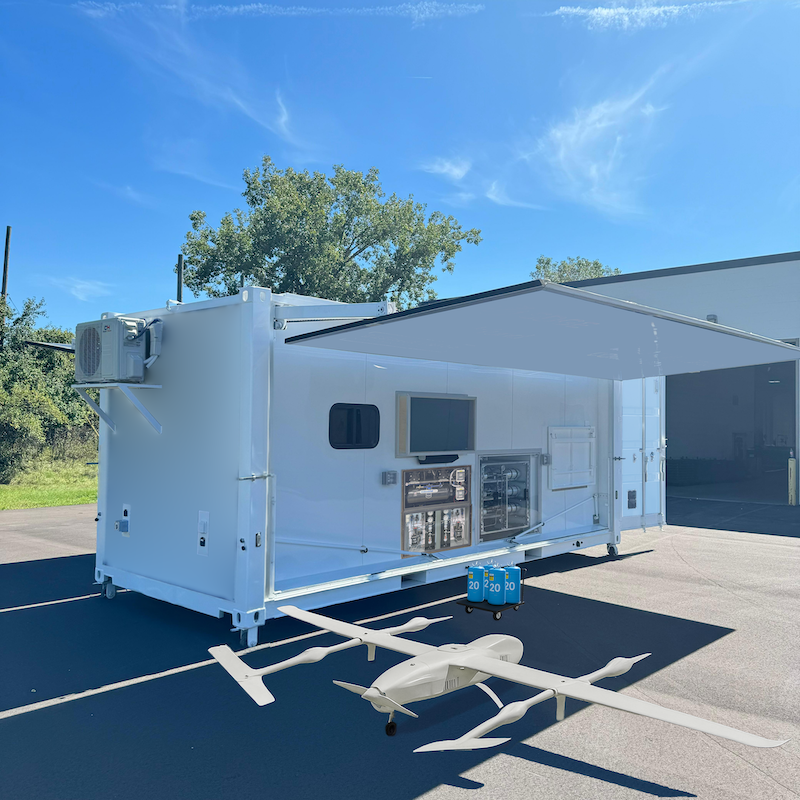US firm unveils mobile hydrogen refueling nanogrid to power long-range military drones

United States-based Sesame Solar – in partnership with Heven AeroTech – has announced the launch of its new drone refueling nanogrid (DRN).
Sesame Solar develops mobile, off-grid power solutions for defense and commercial partners. Heven AeroTech is involved in the development of hydrogen-powered unmanned aerial systems, also known as drones.
The new offering is a comprehensive Surveillance and Drone Refueling Nanogrid solution that includes two Heven AeroTech Z1 drones, satellite communications, edge computing, mobile radar, and atmospheric water generation.
Sesame also claims that the mobile DRNs are manufactured in the USA, aiming to strengthen American manufacturing and energy resilience.
Drones are rapidly being used in different scenarios for various purposes.
Sesame mobile DRNs and Z1 hydrogen-powered Group II VTOL drone
The most prominent one of them is defense, and defense operations rely on the drones for intelligence, surveillance, and logistics support in remote or contested areas.
The drone missions are usually limited by short battery life and frequent refueling needs, which can at times also lead to the human controllers getting exposed on the battlefield.
Sesame and Heven AeroTech believe that the mobile DRNs and Z1 hydrogen-powered Group II VTOL UAS will eliminate these challenges.
In a press release, the companies claim that Sesame’s Mobile DRNs will function as the first closed-loop, mobile refueling stations for Heven’s Z-1 platform.
The combination could deliver over eight hours of flight endurance—up to six times longer than battery-powered systems—and enables drones to operate autonomously in the field for up to six months, Sesame says.
The Sesame DRNs could enable the Heven Z-1 drones to operate continuously in any environment, supporting defense, border protection, and law enforcement agencies in executing challenging missions without relying on external fuel supplies.
Moreover, the company states that the drones can be assembled and deployed in just five minutes—no tools required—and refueled instantly from Sesame’s solid-state hydrogen tanks, thereby eliminating wait times for hydrogen generation.
Surveillance and drone refueling nanogrid
The mobile nanogrids from Sesame provide self-sustaining power and communications solutions for all surveillance and UAS refueling needs—ensuring operational efficiencies and dependencies.
The nanogrids leverage solar power, hydrogen, and battery storage to bring energy to the locations where it’s needed. They are easily transportable and designed to withstand extreme weather conditions. Moreover, the system is designed to be set up in under 15 minutes.
According to the company, the nanogrids can be used and repurposed for up to 20 years. They can also be clustered to form minigrids.
It utilizes retractable solar panels to generate electricity, which powers an integrated Watergen atmospheric water generator. This device extracts humidity from the air to produce clean drinking water and deionized water.
The deionized water is used for producing green hydrogen. The electrolyzer in the system uses the electricity to split water molecules into hydrogen and oxygen. The hydrogen is then stored in solid-state tanks at low pressure, acting as a backup power source to recharge the batteries when solar power generation is low.
The entire system operates as a self-sustaining green energy loop, capable of functioning independently for extended periods.
The Z-1 UAS from Heven
The Group-2 classified Z-1 drone from Heven is powered by hydrogen and offers extended flight time. The runway-independent drone can be deployed from anywhere with its vertical takeoff and landing (VTOL) capability.
Heaven says that the drone is near-silent with a low thermal signature, and it can be easily disassembled into smaller parts for easy transport when needed.
The drone can carry up to 10 pounds (4.5 kilograms) of payload with ease, and has a quick assembly time of five minutes. The one-way range of the drone running on hydrogen is 740 km (459 miles).
The hydrogen-powered drone can also run on batteries, although with reduced endurance and distance.
It combines precision VTOL capabilities with long-endurance performance, making it a versatile solution for long missions. Its modular design enables simple customization for varied operational requirements.
You can find this article on Interesting Engineering's website: https://interestingengineering.com/military/mobile-drone-refueling-nanogrid
